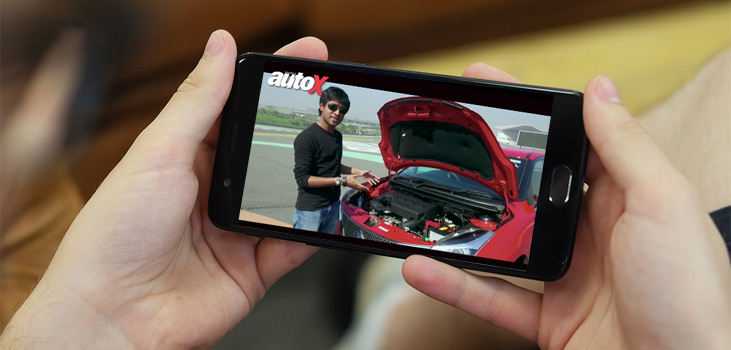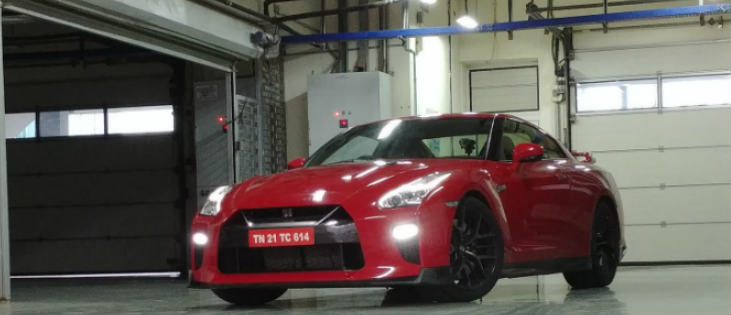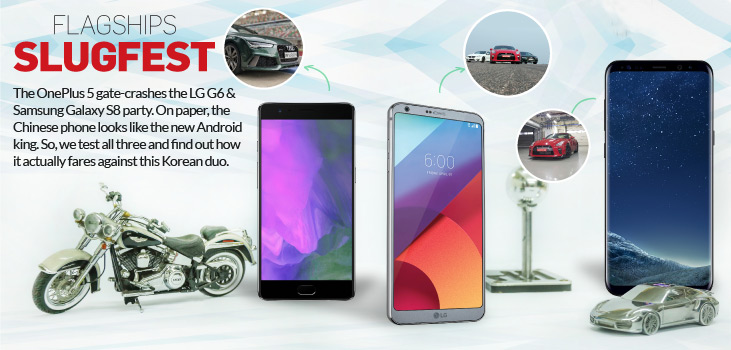The OnePlus 5 gate-crashes the LG G6 & Samsung Galaxy S8 party. On paper, the Chinese phone looks like the new Android king. So, we test all three and find out how it actually fares against this Korean duo.
As the smartphone industry is progressing by leaps and bounds, the battle between its flagship devices is ever evolving with manufacturers consistently bringing innovative features to delight consumers. When it comes to innovation, LG has always been a step ahead – unfortunately, none of its flagship models have been a success in India.
On the other hand, the Samsung Galaxy S8 and its Galaxy range don’t need any introduction – as they’re among the finest flagships available in the market today. The five-year old Chinese start-up, OnePlus, has created a niche space in the Indian smartphone market by not only bringing in premium devices with high-end specifications, but also by introducing features as per the feedback provided by their fans and the OnePlus community forum. Another USP of the OnePlus is that its smartphones cost approximately half the price of the Samsung and LG flagship models, while offering relatively similar performance. We pit these three against each other to find out which one is the king of the Android operating system.
Design
One of the most notable differences between the OnePlus 5 and the Samsung Galaxy S8 is its look and feel. While the OnePlus 5 is wrapped in a full metal unibody, which looks elegant in your hand, Samsung has completely redesigned the Galaxy S8 inside and out. The Galaxy S8 now comes with an infinity display that flows over the edges – for which we believe that Samsung should receive the design crown.
Taking its cues from the Apple iPhone, OnePlus has redesigned its antenna bands and the placement of the dual camera setup now resembles the design of iPhone 7. On the other hand, the LG G6’s design is simple, chunky and looks a bit out-dated. Though it’s a solidly built smartphone, the G6 lacks the finesse of the other two phones.
Plus, the OnePlus 5’s metal body is quite slippery – therefore, we recommend that you get a phone cover to prevent it from falling out of your hand. In the case of the Galaxy S8, the curved sides provide a more secure grip in your hand. Weighing 163 grams, the G6 is slightly heavy in the hand as compared to the Galaxy S8 (155-grams) and the OnePlus 5 (153-grams). While the G6 and S8 are water resistant, the OnePlus 5 is not – so you will have to use it with a certain amount of caution.
Display
The main USP of the Galaxy S8 is its infinity display, which makes both the LG G6 and the OnePlus 5 look jaded in comparison. While the G6 kicked off an era in which premium smartphones are pushing a 18:9 screen aspect ratio, the Galaxy S8’s 5.8-inch quad HD+ display is infinitely better in colour reproduction than the G6’s 5.7-inch QHD+ (2,880 x 1,440 resolution) FullVision display.
As the infinity display of the S8 is edge-to-edge, and by integrating the home button up front, Samsung was able to stretch the display to provide more real estate for your multimedia. And, while the view is wider, the S8 and LG G6 feel small and can be easily accessed with one hand.
The full-HD display of OnePlus 5 is not too bad, as the images rendered on the screen are fairly vibrant and rich in colour. This is how colours look on OnePlus 5

But, while the LG G6 and OnePlus displays are pleasing to the eyes, when compared side-by-side the display of the Samsung Galaxy S8 is simply incredible and we believe that as of now there’s nothing that can match its intensity – thus, making it a clear winner among the three.
Performance
The Samsung Galaxy S8 comes with an Exynos 8895 processor, 4GB RAM and has 64GB of internal storage that can be expanded up to 256GB. And while the OnePlus 5 comes with Qualcomm’s latest Snapdragon 835 processor paired up with either 6GB or 8GB of RAM, the LG G6 is powered by the previous generation Qualcomm Snapdragon 821 processor and is paired with 4GB of RAM.
All three phones perform seamlessly when it comes to everyday tasks, like browsing through apps and playing games, but we found the experience to be much more seamless in the OnePlus 5 thanks to the extra gigabytes of RAM.
During our test, we loaded the OnePlus 5 with apps, and while browsing through them we observed that it was difficult to slow this phone down. Having said that, both the Galaxy S8 and LG G6 deliver a smooth experience as well. At times, both Galaxy S8 and LG G6 felt slightly sluggish when loaded with too many apps running throughout the day – but this isn’t really a deal breaker.
Owing to the Galaxy S8’s refreshed design, Samsung had to move the fingerprint scanner at the back of the device. Instead of placing it in the centre, the fingerprint sensor is positioned next to the camera set-up – a position that users (including me) are not used to, and may find awkward. We found the scanner to be slow and at times inconsistent. The device also packs other unlocking methods, including an iris scanner and facial recognition. But, in reality, these features aren’t used by consumers on a regular basis.
On the other hand, the fingerprint sensor of the OnePlus 5, which is situated up front, is more convenient and is also one of the fastest scanners available on a smartphone.
The LG G6 has its fingerprint sensor at the back, and despite the bigger size of the phone the sensor can be accessed easily and also unlocks the device instantly.
As the operating system plays a vital role in the overall experience, we, therefore, preferred the Samsung and LG, which run on the Android Nougat operating system and are closer to a stock Android experience. The OnePlus 5, on the other hand, works on OxygenOS – which is based on Android – and doesn’t provide as easy-to-use an interface as the other two.
Camera
The OnePlus 5 has a dual camera set-up – one main 16MP camera with f/1.7 aperture and a 20MP camera with f/1.6 aperture. It also packs a 16MP selfie camera with f/2.0 aperture. The LG G6 too comes with dual rear cameras – one standard 13MP, and another 13MP camera with a 125-degree wide-angle lens. The Galaxy S8 sports a 12MP rear camera with dual pixel technology, along with OIS (optical image stabilisation), with f/1.7 aperture and 8MP smart auto-focus sensor at the front with f/1.7 aperture.
The OnePlus 5’s camera is definitely a step up from the 3T, and we really liked the portrait mode that focuses mainly on the subject and blurs everything in the background.

Above image shows how superbly the OnePlus captures portrait mode. However, the portrait mode needs a sufficient amount of light to provide the desired effect – so, sometimes the edges are not very well defined.
The images captured by the LG G6 are sharp and have plenty of detail in them as compared to the OnePlus 5.

The 5MP front camera with an expanded 100-degree field of view reduces edge distortion and makes for more natural images. Unlike the OnePlus 5 and Apple iPhone 7 Plus, there is no “bokeh” (portrait mode) effect in the LG G6, but you can switch between the standard and the wide-angle lens to capture more content in each frame. The lack of OIS on the OnePlus 5 will disappoint photographers, particularly when shooting in low light conditions.
The Galaxy S8 doesn’t have a rear dual camera to boast of, but its uses a single 12-megapixel sensor with a wide f/1.7 lens that uses the Dual Pixel technology, which ensures both the software and image signal processor work together. It captures clear and crisp photos, and thanks to the auto HDR mode it manages to balance out both contrast and exposure levels.
Battery
The LG G6 houses a 3,300 mAh battery, the Samsung Galaxy S8 packs a 3,000 mAh battery and OnePlus 5 has a 3,300mAh with dash charging support. All the three devices can last a day under moderate usage, including web browsing, watching videos, and using social networking sites.
Verdict
The OnePlus 5 comes in two variants – 6GB RAM / 64GB ROM and 8GB RAM / 128GB ROM – and is priced at Rs.32,999 and Rs.37,999 respectively. While the LG G6’s MRP is Rs.51,990, but it is available for Rs.37,000 at leading e-commerce sites. The Samsung Galaxy S8, meanwhile, is priced at Rs.57,900.
While all three smartphones may be separated by price, they offer similar performance for average users. If you can compromise on looks, and want a camera-centric device, then the LG G6 is the one for you. The OnePlus 5 is the jack-of-all-trades, and is the master of specs and performance. But, for me, the Samsung Galaxy S8 is still the best among the three when taking everything into consideration – even if it means that you have shell out more moolah!

